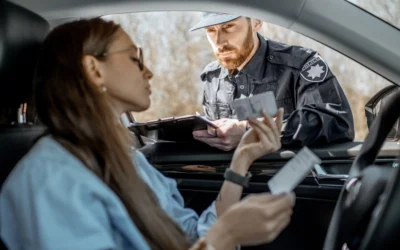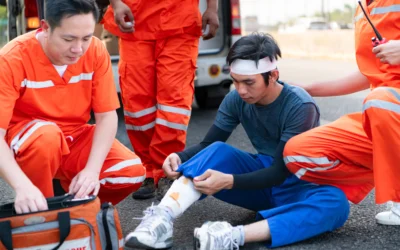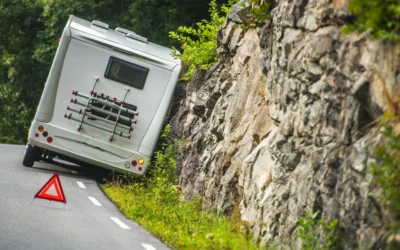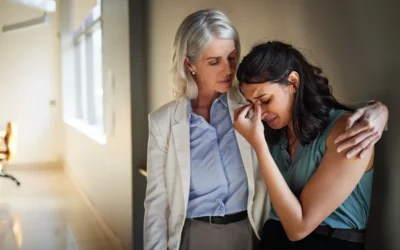What Every Rider Should Know
One moment you’re enjoying the ride—clear skies, open road, total freedom. The next, you’re on the pavement, injured, confused, and wondering what just happened. Motorcycle accidents in Nevada happen fast, and the aftermath can feel like a blur of medical bills, insurance calls, and unanswered questions. If you’re hurting and unsure where to turn, you’re not alone—and what you do next could make all the difference.
This scenario plays out far too often on Nevada’s roads. While our state offers some of the most spectacular riding in the country, it also presents unique challenges that every motorcyclist needs to understand—not just for safety, but for protection when the unexpected happens.
The Hard Truth About Motorcycle Safety in Nevada
Nevada isn’t just a great place to ride—it’s where thousands of passionate motorcyclists call the road home. For many, their bikes are more than machines—they’re a way of life. But the risks are real. Despite making up only a small share of traffic, motorcycles are involved in a significant number of serious and fatal crashes across the state.
These aren’t just numbers—they’re real people. Riders who set out for a normal day and suddenly found themselves facing life-changing consequences. The truth is, many of these accidents could have been prevented. And when tragedy strikes, the law provides options to help you recover physically, financially, and emotionally.
What Nevada Law Requires of Every Motorcyclist
Why the Helmet Rule Matters More Than You Think
Here’s something that surprises many new Nevada residents: you must wear a helmet every time you ride. Nevada Revised Statutes Section 486.231 doesn’t care if you’re 18 or 80, riding around the block or across the state. The law is clear—DOT-approved helmets are mandatory for everyone on a motorcycle.
Some riders grumble about helmet laws, but here’s the reality: your helmet is the one piece of gear that can mean the difference between a hospital stay and a funeral. While violating the helmet law is “only” a civil violation, the real consequences come when you’re lying on the pavement wishing you’d worn one.
Getting Legal to Ride
Your regular driver’s license won’t cut it for motorcycle operation in Nevada. You need proper motorcycle endorsement, which means passing both written and skills tests. The process isn’t just bureaucratic red tape—it’s designed to ensure you have the fundamental skills needed to handle a motorcycle safely.
Many riders skip formal training courses, thinking they can learn on their own. That’s a mistake. Professional instruction covers techniques that could save your life, from proper braking in emergencies to reading road conditions that spell trouble for two-wheeled vehicles.
Minimum Coverage Isn’t Maximum Protection
Nevada requires all motorcyclists to carry liability insurance with minimum coverage of $25,000 per person for bodily injury, $50,000 per accident for bodily injury, and $20,000 for property damage. But here’s what your insurance agent might not tell you: these minimums won’t come close to covering serious motorcycle accident injuries.
A single day in a trauma center can cost more than the full value of some insurance policies. That’s the reality many riders face after a serious crash. Basic coverage might meet legal requirements, but it often falls short when it matters most. Riders who plan ahead carry higher limits and add uninsured motorist coverage—not because they expect the worst, but because they’ve seen what can happen when protection isn’t enough.
Why Motorcycle Accidents Happen (And How to Avoid Them)
The Visibility Problem
Ask any motorcyclist about their biggest fear, and most will tell you it’s other drivers who “don’t see” them. Unfortunately, this isn’t just paranoia—it’s a real phenomenon. Motorcycles occupy a smaller visual space than cars, making them harder to spot, especially in Nevada’s bright desert sunlight that creates challenging shadows and glare.
You can’t control other drivers, but you can control your visibility. Wear bright colors, use your headlight even during the day, and position yourself where you’re most likely to be seen. Assume every driver is actively trying to hit you, and ride accordingly.
Nevada’s Unique Road Hazards
Our state’s diverse geography creates hazards you won’t find everywhere. Desert roads collect sand and debris that can send you sliding. Mountain passes have steep grades and sharp curves that demand respect. Urban areas like Las Vegas and Reno have heavy traffic filled with tourists who don’t know where they’re going.
Weather adds another layer of complexity. Summer temperatures can exceed 115°F, creating dangerous conditions for both you and your bike. Sudden thunderstorms can make roads slick in seconds. Winter brings snow and ice to northern Nevada and higher elevations.
The Human Factor
Let’s talk about the elephant in the room: Nevada’s party culture. Las Vegas attracts millions of visitors who come to drink and gamble, and not all of them make good decisions about getting behind the wheel. Weekend nights are particularly dangerous for motorcyclists.
Distracted driving is another growing problem. Tourists consulting GPS, locals texting, and everyone trying to multitask while driving creates a dangerous environment for vulnerable road users like motorcyclists.
First Steps to Take When a Crash Happens
Immediate Priorities
If you’re conscious and able to move after an accident, your first job is getting to safety. Get yourself and your bike out of traffic if possible. Turn on hazard lights, set up flares, or do whatever you can to prevent additional accidents.
Don’t try to tough it out. Adrenaline masks pain and injury, and what feels like minor soreness could be serious internal damage. Call 911 even if you think you’re fine. Better to be embarrassed about an unnecessary ambulance ride than to collapse from internal bleeding later.
Document Everything
If you’re physically able, become a detective. Take photos of everything: all vehicles involved, the accident scene, road conditions, traffic signs, and your injuries. Get contact information from witnesses—their testimony could be crucial later.
Here’s what not to do: don’t apologize, don’t speculate about what happened, and don’t sign anything except police reports. Insurance adjusters are skilled at getting statements that sound innocent but can hurt your case later.
Medical Care: Not Optional
Seek immediate medical attention, even if you feel fine. Motorcycle accidents can cause hidden injuries that don’t show symptoms right away. Brain injuries, internal bleeding, and spinal cord damage can all present delayed symptoms.
Having immediate medical records also strengthens any future legal claim. Insurance companies love to argue that injuries aren’t serious if you didn’t seek treatment right away.
How Nevada’s Legal System Works for Injured Motorcyclists
Why One Mistake Doesn’t Mean You’ll Lose Your Case
Nevada’s modified comparative negligence law under NRS 41.141 offers hope even when you’re partially at fault. As long as you’re 50% or less responsible for the accident, you can still recover damages. Your compensation gets reduced by your percentage of fault, but something is better than nothing.
For example, if you were speeding when someone made an illegal left turn in front of you, you might be assigned 20% fault while the other driver gets 80%. You’d still recover 80% of your damages—potentially hundreds of thousands of dollars.
What You Can Recover
Nevada law allows recovery for both economic and non-economic damages. Economic damages include medical bills, lost wages, property damage, and future medical care. Non-economic damages cover pain and suffering, emotional distress, and loss of enjoyment of life.
In cases involving drunk driving or other particularly reckless behavior, you might also recover punitive damages designed to punish the wrongdoer and deter similar conduct.
Time Limits Matter
Nevada law gives you two years from the date of your accident to file a personal injury lawsuit. This might seem like plenty of time, but it goes by quickly when you’re dealing with injuries and insurance companies. Don’t wait until the last minute.
Building a Case That Wins
Evidence is Everything
Motorcycle accident cases often come down to competing stories about what happened. Physical evidence can tip the scales in your favor. This includes accident scene photos, police reports, witness statements, and medical records.
Don’t overlook digital evidence either. Cell phone records can prove the other driver was texting. Traffic cameras might have captured the accident. Credit card receipts can show if someone was drinking before driving.
The Medical Paper Trail
Keep detailed records of all medical treatment, from emergency room visits to physical therapy sessions. Document how your injuries affect your daily life. Can’t sleep? Write it down. Missing work? Keep track. Struggling with depression? Get counseling and document it.
Professional Accident Reconstruction
Complex accidents sometimes require professional analysis. Accident reconstruction specialists can examine skid marks, vehicle damage, and road conditions to determine exactly how an accident happened. This expert testimony can be compelling in court.
Common Pitfalls and How to Avoid Them
Don’t Fight Bias Alone
Motorcyclists face unfair stereotypes in legal proceedings. Some people assume all riders are reckless, which can hurt your case. This bias is real, but it’s not insurmountable with proper preparation and skilled representation.
Insurance Company Games
Insurance companies have teams of lawyers and adjusters working to minimize payouts. They might claim your injuries were pre-existing, argue that you weren’t wearing proper gear, or pressure you to accept a quick settlement before you understand the full extent of your injuries.
Don’t go it alone against these professionals. They have experience and resources. You need someone on your side who knows their tactics and can fight back effectively.
Understanding Your Injuries
Motorcycle accidents often cause complex injuries that take time to fully manifest. Traumatic brain injuries, spinal cord damage, and internal injuries can have long-term consequences that aren’t immediately apparent. Don’t settle your case until you have a complete picture of your medical situation.
Prevention Is Still the Best Protection
Ride Like Everyone is Trying to Kill You
This sounds extreme, but it’s actually good advice. Assume every driver is distracted, drunk, or actively trying to hit you. This mindset keeps you alert and ready to react to dangerous situations.
Gear Up Every Time
Quality protective gear can mean the difference between walking away from an accident and spending months in rehabilitation. Always wear:
- A DOT-approved helmet with face protection
- Leather or abrasion-resistant jacket
- Long pants (leather or reinforced material preferred)
- Over-the-ankle boots
- Gloves for grip and protection
Keep Your Bike in Top Shape
Regular maintenance isn’t just about performance—it’s about safety. Check tire pressure and tread regularly. Ensure brakes are working properly. Replace worn parts before they fail. A mechanical breakdown at highway speeds can be fatal.
Know Your Limits
Nevada’s varied terrain and weather conditions can challenge even experienced riders. Don’t ride beyond your skill level, and don’t ride in conditions that exceed your comfort zone. There’s no shame in pulling over when conditions become dangerous.
Key Points Every Nevada Motorcyclist Should Remember
- Nevada requires DOT-approved helmets for all riders, no exceptions
- Minimum insurance coverage is 25/50/20, but higher limits are recommended
- You can still recover damages even if you’re partially at fault (up to 50%)
- Document everything if you’re in an accident
- Seek immediate medical attention regardless of how you feel
- You have two years to file a personal injury lawsuit
- Insurance companies work to minimize payouts—don’t face them alone
- Quality safety gear and defensive riding are your best protection
Frequently Asked Questions
What if I wasn’t wearing a helmet during my accident? You can still recover damages, but not wearing a helmet might reduce your compensation under Nevada’s comparative negligence law. The court could find that your failure to wear a helmet increased the severity of your injuries.
Can I recover damages if the other driver doesn’t have insurance? If you have uninsured motorist coverage, it should cover your damages. Without this coverage, you might need to pursue the at-fault driver personally, though this can be challenging if they lack assets.
How long do I have to file a claim? You have two years from the accident date to file a personal injury lawsuit in Nevada. However, it’s best to consult with an attorney promptly to preserve evidence and protect your rights.
What if I was partially at fault? Nevada’s comparative negligence law allows recovery as long as you’re 50% or less at fault. Your compensation will be reduced by your percentage of fault.
Should I accept the insurance company’s first offer? Almost never. Initial offers are typically far below the true value of your claim. You should fully understand your injuries and their long-term impact before considering any settlement.
Do I need a lawyer for my motorcycle accident case? While not legally required, motorcycle accident cases are complex and insurance companies have experienced attorneys working to minimize payouts. Having skilled legal representation significantly improves your chances of fair compensation.
When You Need Help, We’re Here
Motorcycle accidents can turn your world upside down instantly. The physical pain, emotional trauma, and financial pressure can feel overwhelming, especially when you’re trying to recover from serious injuries. You shouldn’t have to face this challenge alone.
At Joey Gilbert & Associates, we understand what motorcyclists go through both on the road and in the courtroom. We’ve seen how insurance companies try to take advantage of injured riders, and we know how to fight back. Our approach combines thorough preparation with aggressive advocacy to ensure you receive fair compensation.
Don’t let an insurance company decide your future. Your case deserves attorneys who understand motorcycle accidents and aren’t afraid to take on big insurance companies. We work on a contingency fee basis, so you don’t pay unless we win your case.
The road to recovery starts with making the right choice. Contact Joey Gilbert & Associates today for a free consultation. Let us handle the legal fight while you focus on healing. Your future may depend on the decision you make right now.




